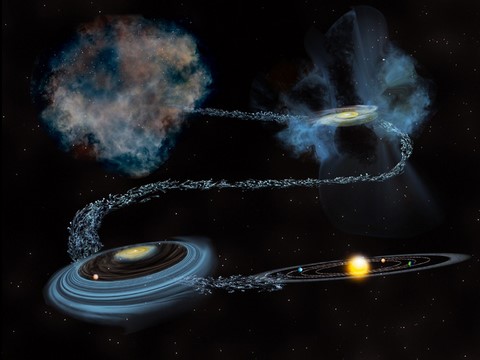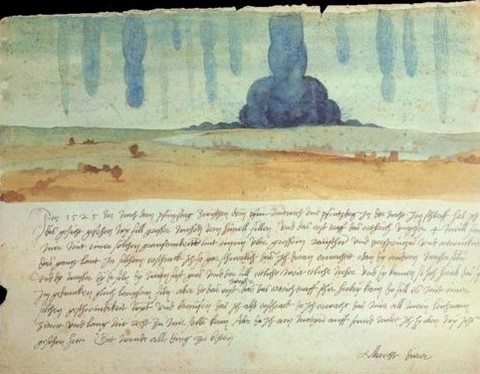Water on Earth is older than the Sun
- at least, 50% of it...
The question of the origin of water on Earth has been dodging scientists for a long time. Did it originate in the solar system itself? Within the disk of gas and dust which rotated around the young Sun and out of which formed four and a half billion years ago the planets, comets and asteroids? Or is water even older, stemming from the cold molecular cloud out of which our sun itself was born?

An illustration of water in our solar system through time from before the Sun’s birth through the creation of the planets. Bill Saxton, NSF/AUI/NRAO
To answer that question, a team led by astronomer L. Ilsedore Cleeves of the University of Michigan, Ann Arbor, focused on deuterium, a heavy form of hydrogen that was created in the big bang along with normal hydrogen. There are about 26 deuterium atoms for every million hydrogen atoms across the universe, but it is six times as prevalent in the water on Earth and in other solar system bodies. Scientists conclude that when the water formed, the reaction creating deuterium-rich “heavy water” was slightly faster than the one creating normal water, so the proportion of deuterium in water increased.
But that enrichment of deuterium happens only under certain conditions: It has to be very cold (only a few tens of degrees above absolute zero), plus you need oxygen and some sort of ionizing radiation to get the reaction going. All of those things are available in the ISM (Inter Stellar Medium). The ionizing radiation there is cosmic rays, particles from distant sources that zip through space at high speed. And astronomers have observed water in the ISM that is highly enriched in deuterium, so that could be source of the solar system’s water.
Still, there’s a question mark over whether this interstellar water could survive the violence of the sun’s birth. To find out, Cleeves and her colleagues sought to determine whether the same water-forming reactions could have occurred after the sun’s formation, in the protoplanetary disk of gas and dust from which planets form. Such a disk would offer low temperatures and an oxygen supply just as the ISM does, but would there be enough ionizing radiation?
The team constructed a detailed model of the chemical processes creating water in a protoplanetary disk. Much of the cosmic rays are fended off by the young star’s magnetic field and particles streaming out from the star, but there are other sources of radiation: x-rays from the star and short-lived radionuclides in the disk. As the researchers report online in Science, those sources of radiation just don’t produce heavy water fast enough. “We found that heavy water didn’t form in any abundance over a million years,” Cleeves says.
In fact, the team estimates that as much as 50% of the water now on Earth may have existed since before the birth of the sun 4.5 billion years ago. And that’s good news for other planetary systems. The conditions in the ISM are far more uniform across space than those in protoplanetary disks, so it’s likely that there is water everywhere waiting for planets to form. “As the number of confirmed planetary systems increases, it’s reassuring that … water is available,” Cleeves says.
"Why this is important? If water in the early solar system was primarily inherited as ice from interstellar space, then it is likely that similar ices, along with the pre-biotic organic matter that they contain, are abundant in most or all protoplanetary disks around forming stars," Carnegie's Conel Alexander, one of the leaders on the study, says.
"But if the early solar system's water was largely the result of local chemical processing during the sun's birth, then it is possible that the abundance of water varies considerably in forming planetary systems, which would obviously have implications for the potential for the emergence of life elsewhere."
“This is a very interesting result. We’ve been debating this for years, whether or not the ices have an interstellar heritage,” says astrophysicist Karen Willacy of NASA’s Jet Propulsion Laboratory in Pasadena, California. She says that other groups have tried to model the collapse of clouds in the ISM into planetary systems to see if ice would survive, but “with various results, that don’t always agree,” Willacy says. “This is much more simple approach, just using the chemistry which is well understood.”
Adapted from: Daniel Clery in Science AAAS.
Readings: Alfred de Grazia: Lately Tortured Earth (1982)

Here are some readings from Alfred de Grazia's Lately Tortured Earth, printed in Bombay, India, in 1982.
Albrecht Dürer: the Deluge, picture from a 1525 dream.

